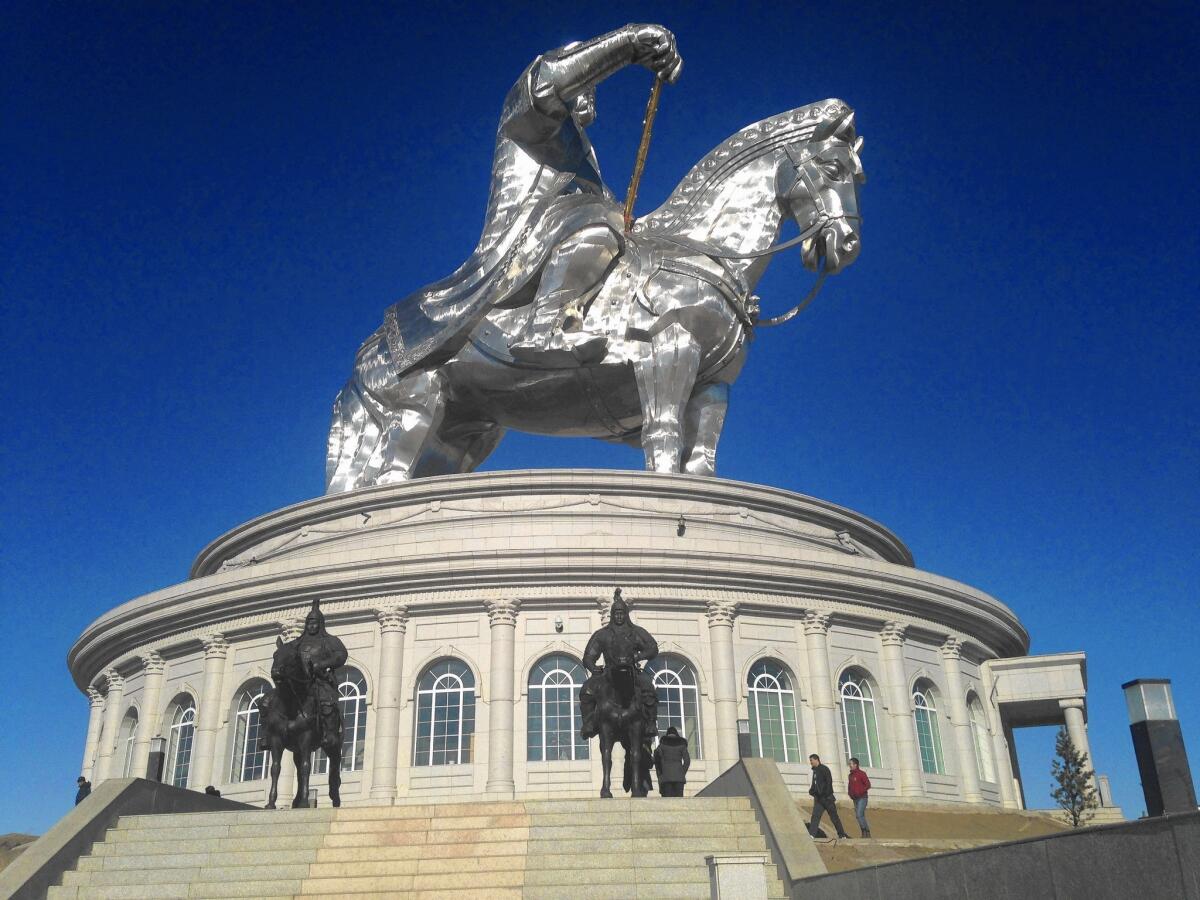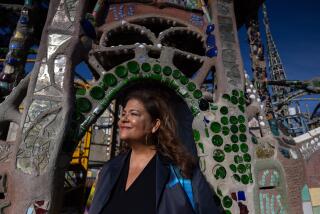Genghis Khan reigns anew as Mongolia replaces Communist-era statues

A 131-foot-tall stainless steel statue of Genghis Khan was built in 2009 by a Mongolian tour company.
- Share via
reporting from Ulan Bator, Mongolia — The advertisements in the magazine of Mongolia’s national airline signal much about what’s happening these days in this sparsely populated, resource-rich country of 3 million sandwiched between Russia and China.
Double-page spreads tout Samsung smartphones and HDTVs, upscale hotels and drilling equipment for mineral mines. But one advertisement stands out: a fundraising appeal for the Grand Maitreya Project, an effort to construct a 177-foot-tall golden statue of the Buddha of Loving Kindness in front of a giant white stupa, a Buddhist commemorative monument, which at 354 feet high would eclipse the Statue of Liberty.
A hotline promises donors information, but for those ready to send funds immediately, a bank Swift code and account number are provided as well (U.S. dollars and Mongolian tugriks both welcome).
After spending centuries under the thumb of China and seven decades as an atheistic Soviet satellite, Mongolia became a democratic state in 1990. In the quarter-century since, the nation has been on a mission to reclaim and redefine its identity and reevaluate its history. Perhaps nowhere is this quest more evident than in the flurry of statue building — and tearing-down — that has erupted in recent years.
Buddhas, the Beatles and Genghis Khan are in. Stalin and Lenin are most definitely out.
“The lack of national identity is one of our biggest problems,” said Munkhdul Badral Bontoi, chief executive of Cover Mongolia, a business consultancy in Ulan Bator. “In the 13th century we had Genghis Khan, and we’re searching for the same level of unity now — a common goal. We sort of had that in Communist times: Everyone grew up with propaganda about creating a prosperous country together. That experiment failed, but we did have something to collectively rally around.”
Ulan Bator’s main Stalin statue was ripped down in the winter of 1990, just after the democratic revolution. It took until fall 2012 for the capital to rid itself of its last Vladimir Lenin statue, which was lifted off its plinth by a crane, plopped onto a flatbed truck and sent off to auction, with Mayor Bat-Uul Erdene condemning the Bolshevik revolutionary as a “murderer.”
(Earlier, the capital had shut down its Lenin museum and repurposed the decrepit building into offices, restaurants, bars and now, ironically, a dinosaur museum.)
In place of Russian strongmen, Genghis Khan has clearly been the go-to figure. Officially dismissed as a “reactionary” during the socialist era, the founder of the great Mongol empire has been rehabilitated on a massive scale — literally.
An imposing likeness of him, sitting in a pose reminiscent of Honest Abe at Washington’s Lincoln Memorial, was unveiled in 2006 in front of the parliament. (His face has also been placed on various denominations of currency and his name affixed to the capital’s airport, not to mention a raft of commercial products, including a line of vodka.)
About an hour’s drive east of Ulan Bator, a 131-foot-tall stainless steel Genghis Khan on horseback was built out of the sandy steppe in 2009 by a Mongolian tour company. For a fee, visitors can ride an elevator up through the equine’s torso and emerge atop the head of the steed for a panoramic view of the stark landscape.
Scores of other monuments, large and small — commemorating animals, songs, musicians, poems, religious figures and more — have been erected around the country as well.
Mongolia has a long tradition of sculpture. The 17th century statesman and Buddhist lama Zanabazar, for instance, was a ground-breaking artist known for his exquisite gilt bronze religious figures; today he’s often called the “Michelangelo of the Steppes.”
With freedom of religion restored under democratic rule, Buddhist monasteries were reopened. In 1996, an 87-foot gilt bodhisattva of compassion, Avalokiteshvara, was dedicated at the capital’s Gandan Monastery, replacing the 1911 original, which was destroyed by Communists in 1938.
The same year that Genghis was installed at the parliament, a 75-foot Buddha — funded by donations from South Korea — was erected in a park on the south side of Ulan Bator.
Around Ulan Bator, dozens of new sculptures — some momentous and mournful, others whimsical or even trivial — have been dedicated in parks, along roadsides and on street corners.
The first statue crafted in the democratic era was a memorial to the victims of Communist-era political purges. Made in 1991 and unveiled in front of the National Museum, its black cubic structure symbolizes oppression and grief, and the figure of a broken human torso with a head soaring upward is said to “reflect the tragic fate of the condemned yet their resolve and hope to seek the truth in light.”
A bronze likeness of slain parliament member and democratic activist Sanjaasurengiin Zorig, who was killed in 1998, was erected near the edge of the central square.
A block east stands Marco Polo, who went up in 2011. A block south you can find Mongolia’s first holder of a doctorate degree, who got his own statue in 2005 in front of the national library.
The late composer S. Tsogtsaikhan, whose song “Sound of Bell” became the anthem of the democratic revolution, was honored in December, with his guitar-toting likeness going up on the west side of town.
There are even testaments to songs themselves. The patriotic tune “My Adored Homeland” is commemorated on a granite boulder, with its first stanza (notes and all) inscribed on the rock. The national anthem, too, has its own monument, which actually plays the tune when visitors approach.
A famous and beloved 1956 children’s ditty, “Come Along My Little Buddy,” got its own monument in 2011. The Beatles were honored in 2008 with an apple-shaped memorial in a plaza in front of the State Department Store (all funds, the city notes in a plaque, were raised from fans of the Fab Four).
There are statues depicting traditional Mongolian ways of life: “Boy With Bowl of Yogurt,” “Boy With Yak” and “Boy With Saddle” were dedicated in 2008, along with others depicting wrestling and horses. A poem, “My Adored Homeland,” was inscribed on a large slab of granite in 2003.
A number of statues remain from the Communist days. In front of the parliament, at the center of a huge square, is Damdin Sukhbaatar, a socialist hero who in 1921 declared Mongolia’s final independence from the Chinese. The statue was overhauled a few years ago, but in 2013 city leaders decided to strip Sukhbaatar’s name from the plaza and rededicate it to Genghis Khan.
Perhaps the most controversial socialist-era monument still in place is a statue of Khorloogiin Choibalsan, a military leader who served as prime minister of Mongolia from 1939 to 1952 and established the nation’s first university.
Standing in front of the school, now known as the National University of Mongolia, his likeness was for years vandalized with paint by detractors who regard his rule as despotic. Often called the “Stalin of Mongolia,” Choibalsan oversaw the political purges whose victims are now commemorated with their own monuments in Ulan Bator.
But Choibalsan continues to have his supporters, who say he helped modernize the nation and repel Japanese invaders. A few years ago, his statue was renovated, and the vandalism has died down. A city-erected plaque refers to the monument with ambivalence, noting tersely that the statue is the “only one in Ulan Bator to ever have been dedicated to a living person” and was erected “during the height of his cult of personality.”
Oyuntsetseg Suidaan, a professor in the school of Arts and Sciences, supports the decision to retain the Choibalsan monument and others from that era.
“It’s all part of the history of the country,” she said. “If we tear it all down, aren’t we more likely to forget what happened?”
More to Read
Sign up for Essential California
The most important California stories and recommendations in your inbox every morning.
You may occasionally receive promotional content from the Los Angeles Times.











